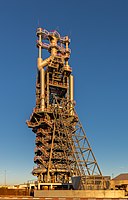
Photo from wikipedia
In this study, a novel method for producing direct reduced iron (DRI) powders based on microwave-assisted self-reduction of core-shell composite pellets composed of blast furnace (BF) dust and hazardous electric… Click to show full abstract
In this study, a novel method for producing direct reduced iron (DRI) powders based on microwave-assisted self-reduction of core-shell composite pellets composed of blast furnace (BF) dust and hazardous electric arc furnace (EAF) dust followed by magnetic separation was reported. The proper core-shell structure of the composite pellets was designed according to the rule of impedance matching and properties of BF dust and EAF dust by adjusting the thickness of shell (i.e., thickness of impedance matching layer) via controlling the C/O molar ratio of the raw materials from 0.55 to 0.70. The results showed that the EAF dust with high content of CaO was beneficial to the mechanical strength of green, dried, and metallized pellets (collected after reduction), while the BF dust with high content of carbon enabled sufficient microwave-assisted reduction of the pellets, facilitating subsequent magnetic separation and also the removal of zinc from EAF dust. By reduction of the core-shell BF dust-EAF dust composite pellets with the C/O molar ratio of 0.65 at 1050 °C for 15 min, the resulting metallized pellets showed superior reduction and magnetic separation indexes with higher removal percentages of zinc and lead, in comparison with conventional metallized pellets. The DRI powders obtained after magnetic separation had total iron content of 91.2 wt%, iron metallization degree of 95.8%, yield of 68.1%, and iron recovery of 88.0%. This study provided a good example for efficient and environmentally friendly comprehensive utilization of typical and hazardous wastes in the iron and steel industry.
Journal Title: Waste management
Year Published: 2021
Link to full text (if available)
Share on Social Media: Sign Up to like & get
recommendations!